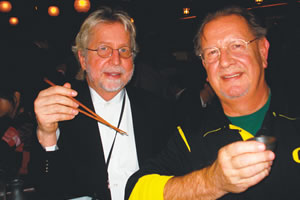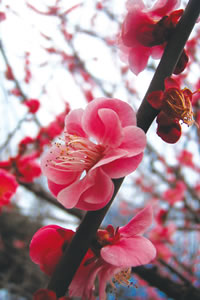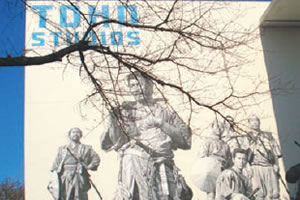A Japan Visit Just Before The Quake

With Kamasami Kong at Gonpachi
What follows is a column I wrote after a visit to Japan in February and March, one of the greatest vacation weeks of my life, which included one of my best birthday celebrations. But eight days after I departed Tokyo, just as MidWeek was ready to go to press, the March 11 earthquake and tsunami hit Japan. I pulled the column, deciding to wait until the situation there was improved to publish my account. That day, sadly, now seems far in the future, especially with the threat of radiation poisoning in and around Tokyo. I loved everything about Japan – the food, the people, the equal embrace of the traditional and the modern. So I offer this now, a sort of tribute to the Japan I experienced and fell in love with, and with a deep hope that life there will soon be much closer to “normal.”
What a difference a new airport makes. In this case, Tokyo International Airport at Haneda. It’s not new new, but it is a new destination for Hawaiian Airlines, and made a huge quality-of-vacation contribution to my recent Japan visit.
Instead of three inconvenient hours of ground travel (train-train-bus) and suitcase schlepping to get from and to Narita, it was just 45 minutes from Haneda to my destination. Which translates to a total of four and a half more hours of eating sushi and drinking sake – or whatever else you’d rather be doing besides Tokyo traffic.
Haneda also provides another opportunity to fly what, in my experience, is the best airline in the world these days. Yes, Hawaiian, and not just because of its superlative on-time record or that it’s local. The level of customer service, both on the ground and in the air, should be the goal of every Hawaii company. And the few times I’ve upgraded to business class, well, it doesn’t get any better.

Ume blossoms in Tokyo
For sure, this will not be my last trip to Japan via Haneda (where security does not make you remove your shoes).
One of the highlights of this trip was seeing my old friend Kamasami Kong, the former Honolulu deejay and original host of The Hawaiian Moving Co. He’s huge in Asia, doing radio shows in Tokyo, Osaka and Taipei, and publishing a magazine. Every big-name star coming through Japan makes it a point to appear on one of his shows. And he hosts “World Pop Network: Japan” on one of Hawaiian’s music channels. Kong’s gigs include a Saturday morning Hawaiian music show. Yes, it was a bit odd hearing the Ka’u Crater Boys, Loyal Garner and Anuhea in Japan, but cool too.
The previous night Kong provided a walking tour of Shibuya, the super-hip area of Tokyo where 75 percent of people seem to be under age 30. The main intersection – bounded by tall buildings with five or six huge video screens blasting music; “girl bands” are the in thing now, from both Japan and Korea – is said to be the most populous place on earth, with about 2.5 million people transiting the four-way crossing in any 24-hour period. Stepping off the curb into the multi-directional pedestrian crossing is a rather intimidating event – but exciting too – with literally thousands of people pouring into the intersection. A true flood of humanity.
Our evening ended at nearby Gonpachi, the restaurant Quentin Tarantino re-created for that sword fight scene in Kill Bill (Kong’s guest the previous Friday was Sam Choy). Manager Kenji Sato (who is of Japanese-Cuban heritage and looks like his last name ought to be Iglesias) runs a place with great food and fun attitude.
Another highlight was visiting Meguro Gajoen – since 1931 a receptacle of Japan’s traditional arts. So remarkable is its collection that during the World War II bombing of Tokyo, Doolittle’s Raiders were ordered to avoid that area of the city to prevent damaging Meguro Gajoen and its “100 stairs” of traditional culture.

The Seven Samurai was made here
Remarkably, just a few steps away from the electric Shibuya intersection is the Meiji Jingu shrine, a huge wooded oasis of 120,000 trees (365 varieties), nature paths, babbling streams and placid lakes. It’s dedicated to the late Emperor Meiji, one of Japan’s most enlightened and generous leaders, and his consort Empress Shoken.
The close proximity of the Meiji Jingu shrine to Shibuya is Japan in a clam shell – exquisitely traditional, extremely modern, each offering its own varied pleasures.
And while I was a bit early for sakura (cherry blossom) season, pink and white ume (plum) blossoms were everywhere – delicate but hardy enough to withstand overnight temperatures that approached freezing.
There were many other highlights: a huge orchid show at the Tokyo Dome that covered the entire stadium floor; lunch across from the Tokyo Dome at the Baseball Cafe, which is dedicated to U.S. baseball; being photographed with Godzilla outside Toho Studios in Setagaya-ku; Jidayuburi Park’s historic Japanese village, including an 1800s wine shop and fire station; the stunning mountain resort of Hakone (90 minutes by train from Tokyo) and soaking in an ofuro; taking the Hakone Ropeway “gondora” (as the sign there called it) which carries more than 2 million people annually to the sulphur-steaming volcanic Owakudani mountain; visiting The Little Prince Museum at Hakone, with its European gardens and cafe (yes, a museum in Japan dedicated to the book by a French author); seeing majestic Mount Fuji, and enjoying fantastic food at every meal.
Post-script: As it happens, Hawaiian’s Haneda service has been invaluable in allowing both Americans and Japanese to flee the constant aftershocks, the threat of radiation, the rolling blackouts and inconsistent train service … Though built before Tokyo structures were mandated to be earthquake-proof, Meguro Gajoen survived with its treasures intact, and several events previously scheduled there have become fund-raisers for tsunami relief … Among the accomplishments for which Empress Shoken is so beloved even today is that she helped bring the Red Cross to Japan. Thank goodness she did. dchapman@midweek.com



